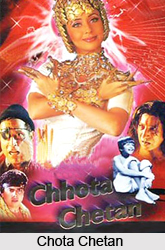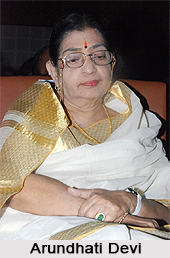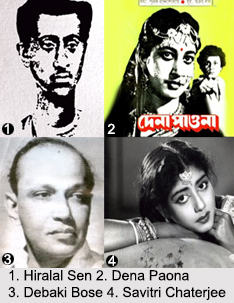 Bengali cinema has its own importance in the Indian film industry. It comprises talented directors, actors, actresses, cameramen, music directors and other technicians. Bengali cinema goes through a lot of experiments before its execution. It is rich with variety of subject matter.
Bengali cinema has its own importance in the Indian film industry. It comprises talented directors, actors, actresses, cameramen, music directors and other technicians. Bengali cinema goes through a lot of experiments before its execution. It is rich with variety of subject matter.
History of Bengali Cinema
The history of Bengali cinema dated back to those days when the first bioscope was introduced in Kolkata in 1980. It has come along a long way since its inception. Initially it was stage actors who shouldered the responsibility of establishing the Bengali film industry successfully. It flourished first in Hiralal Sen`s silent movie, "Billwamangal" released in 1919 produced by the "Madan Theatre Company of Calcutta". After six years the first Indian feature film "Raja Harish Chandra" was released. The Talkies began in early 1930s. "Dena Paona" is first Bengali cinema as a talkie in 1931.
With the coming of the talkies in the early "30s, new studios became prominent in Bengal and most famous being Birendranath Sircar"s "New Theatres Ltd." which was established in 1930. "New Theatres" landmark films were Debaki Bose"s "Chandidas" (1932), Pramathes Barua"s "Debdas" (1935) and "Mukti" (1937) and Nitin Bose"s "President" (1937). Pankaj Kumar Mallick, music director at New Theatres, first made use of Rabindra Sangeet in Barua"s "Mukti". The studio created singing stars like Umasashi, Kananbala and K.L. Saigal. In the "50s, Bengali cinema also produced its most iconic star duo, Uttam Kumar and Suchitra Sen. Uttam Kumar remained Bengali cinema"s top hero for over two decades and his death on 24th July 1980 almost brought the Bengali industry to a standstill. Kanon Devi was considered to be the earliest actress in Bengali cinema. Later on Savitri Chaterjee, Madhavi Mukherjee, Supriya Devi, Sharmila Tagore are note worthy. After them a group of very talented, versatile actresses came and Deboshree Roy topped the list. Indrani Halder, Shatabdi Roy, Rituparna Sengupta did well in contributing much to the Bengali cinema.
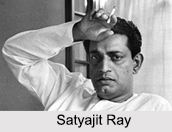 The best-known "event" of the "50s Bengali cinema is nonetheless Satyajit Ray"s "Pather Panchali" which released in 1955 and won "Best Human Document" at the 1956 Cannes Film Festival. "Pather Panchali" was appreciated by filmgoers and critics alike, as was "Apur Sansar", the third film of Ray"s "Apu trilogy", which had a "silver jubilee" in Kolkata. "Apur Sansar" introduced Soumitra Chatterjee, who along with Uttam Kumar became Bengali cinema"s top male star, and also worked in Ray"s classics like "Charulata" (1964). Ray worked with Uttam Kumar in "Nayak" (1966), a film supposedly inspired by Uttam"s iconic recognition. "Jalsaghar" (1958), "Ajantrik" (1958), "Neel Akasher Neechey" (1959), "Devdas" (1955), "Devi" (1960), "Meghe Dhaka Tara" (1960), "the Calcutta trilogies" (1971-1976), etc are also note worthy.
The best-known "event" of the "50s Bengali cinema is nonetheless Satyajit Ray"s "Pather Panchali" which released in 1955 and won "Best Human Document" at the 1956 Cannes Film Festival. "Pather Panchali" was appreciated by filmgoers and critics alike, as was "Apur Sansar", the third film of Ray"s "Apu trilogy", which had a "silver jubilee" in Kolkata. "Apur Sansar" introduced Soumitra Chatterjee, who along with Uttam Kumar became Bengali cinema"s top male star, and also worked in Ray"s classics like "Charulata" (1964). Ray worked with Uttam Kumar in "Nayak" (1966), a film supposedly inspired by Uttam"s iconic recognition. "Jalsaghar" (1958), "Ajantrik" (1958), "Neel Akasher Neechey" (1959), "Devdas" (1955), "Devi" (1960), "Meghe Dhaka Tara" (1960), "the Calcutta trilogies" (1971-1976), etc are also note worthy.
Satyajit Ray"s contemporary Ritwik Ghatak was an influential member of the Indian People"s Theatre Association and spearheaded the more political avant-garde cinema. In the "70s, Mrinal Sen"s films depicted the contemporary social turmoil and the rise of a drastic politics in West Bengal. Sen"s "Akaler Sandhane" recreates the 1943 Bengal famine, won the Silver Bear at Berlin in 1981. In the same year, Aparna Sen made her first film "36 Chowringhee Lane", becoming best known as a feminist filmmaker with "Paroma" (1985).
Satyajit Ray received an Oscar for his lifetime"s work days before his death on 23rd April 1992. It marked the end of an era, but the "90s also saw the rise of a young director in the Ray mould- Rituparno Ghosh, whose films returned urban middle-class audiences to Bengali cinema.
Modern Era of Bengali Cinema
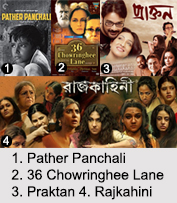 The revitalization of Bengali cinema dates from the rise of directors such as Rituparno Ghosh, Aparna Sen and Gautam Ghose. Rituparno made his first film "Hirer Angti" in 1992 and dominated Bengali cinema until his death in 2013, winning several national awards for films like "Unishe April", "Dahan" and "Utsab". Aparna Sen made her directorial debut in 1981 with the internationally lauded "36 Chowringhee Lane", which looked at the lives of Anglo-Indians living in Kolkata. Her later films have also been celebrated: "Paromitar Ek Din", "Mr and Mrs Iyer", "15 Park Avenue", "The Japanese Wife", "Goynar Baksho", etc. Gautam Ghose is best known for award-winning films like "Dakhal", "Paar", "Padma Nadir Majhi" and "Abar Aranye".
The revitalization of Bengali cinema dates from the rise of directors such as Rituparno Ghosh, Aparna Sen and Gautam Ghose. Rituparno made his first film "Hirer Angti" in 1992 and dominated Bengali cinema until his death in 2013, winning several national awards for films like "Unishe April", "Dahan" and "Utsab". Aparna Sen made her directorial debut in 1981 with the internationally lauded "36 Chowringhee Lane", which looked at the lives of Anglo-Indians living in Kolkata. Her later films have also been celebrated: "Paromitar Ek Din", "Mr and Mrs Iyer", "15 Park Avenue", "The Japanese Wife", "Goynar Baksho", etc. Gautam Ghose is best known for award-winning films like "Dakhal", "Paar", "Padma Nadir Majhi" and "Abar Aranye".
In recent years, a younger generation of Bengali directors have come to the fore. Successful Bengali films are getting their Hindi remakes in Bollywood ("Bela Seshe", "Praktan", "Rajkahini"). Some of the directors who have gained success in recent years are Anik Dutta, Aniruddha Roy Chowdhury, Dhaananjoy Mandal, Anjan Dutta, Arindam Sil, Aditya Vikram Sengupta, Indranil Roychowdhury, Kaushik Ganguly, Kamaleswar Mukherjee, Mainak Bhoumik, Srijit Mukherji, Nandita Roy and Shiboprosad Mukherjee (who have made several films as a duo).Bengali directors who have found artistic and commercial success in contemporary Hindi films are: Anurag Basu, Ayan Mukerji, Dibakar Banerjee, Pradeep Sarkar, Shoojit Sircar and Sujoy Ghosh.
Awards of Bengali Cinema
The National Film Award for Best Feature Film in Bengali is one of the National Film Awards presented annually by the Directorate of Film Festivals. Bengal Film Journalists` Association Awards is the oldest Association of Film critics in India, founded in 1937. Anandalok Awards is a ceremony which is one of the most prominent film events given for Bengali cinema in India. Kalakar Awards is the ceremony recognized as another topmost awards ceremony of Bengali cinema. Tellysamman Awards is organized by Sangbad Pratidin, a Kolkata based Bengali daily. Zee Bangla Gourab Somman Awards are designed for the people by the people of Bengal.
